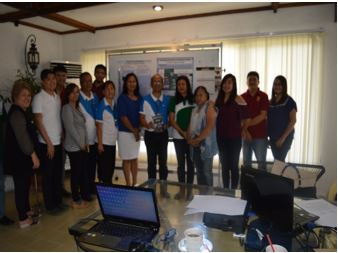The University of the Philippines Los Banos (UPLB) Limnological Station has released a technical bulletin titled “Biology of Knifefish (Chitala ornata) in Laguna de Bay” to help fisherfolk and the general public understand the biology, behavior, and movement of this invasive species. The bulletin is an output of the Philippine Council for Agriculture, Aquatic and Natural Resources Research and Development (PCAARRD)-funded Research and Development (R&D) Program, “Towards the Control and Management of the Invasive Knifefish in Laguna de Bay”.
The knifefish, known scientifically as Chitala ornate, has been described as “invasive” because its ability to prey on native and economically important species has led to reduced catches, particularly of tilapia, both in open waters and aquaculture cages.
Without any known predator or competitor in Laguna de Bay, its population grew fast, reaching up to 40% of the fish catch at its peak.
A research team led by Dr. Ma. Vivian Camacho of UPLB’s Institute of Biological Sciences, studied the breeding and reproductive behavior of knifefish in relation to their period of abundance in the lake. The two-year study showed that knifefish exhibit seasonal spawning, with March-May as peak period. The parent fish creates a nest or pit around the bamboo pole where the eggs are attached and one or both parents guard the nest until the eggs are hatched. The parental care ensures that most of the eggs survive which contributes to their reproductive success. According to Dr. Camacho, physical removal such as harvesting and overfishing are effective in controlling the knifefish population. This observation is supported by estimates of population parameters. However, control by harvesting can be most successful prior to spawning and during schooling of juveniles.
The team also monitored the movement of knifefish to find the locations where the fish tends to aggregate. The movement study was undertaken using mark-recapture technique where fish are tagged prior to release. Results show that large knifefish (50-75 centimeters (cm) can travel 1.1 kilometer in less than 24 hours while smaller ones (19-29 cm) usually travel at shorter distances.
Adult knifefish tend to stay near fishpens while smaller juveniles usually stay near land areas with submerged vegetation (Vallisneria sp). Their stomach content show that small- sized fish feed primarily on shrimp such as ‘yapyap’ and ‘hipon’ while large-sized fish feed more on fishes. Based on their feeding behavior, baited fishing methods such as ‘kitang’ (longline) is effective for catching. The recommended schedule for catching is from 4 to 7 AM or 7 to 10 PM, the period which coincides with their feeding.
Three posters, namely, on the reproductive biology, population dynamics, and feeding ecology of knifefish in Laguna de Bay were also produced by the program.
Copies of the bulletin were turned over by Dr. Camacho to PCAARRD Executive Director Dr. Reynaldo V. Ebora and the members of the Interagency Technical Working Group (TWG) on the Containment of Knifefish in Laguna de Bay during the TWG meeting recently held at PCAARRD.

